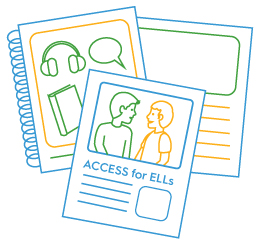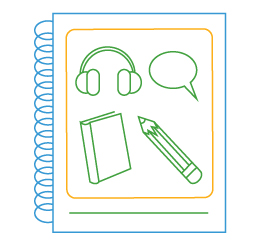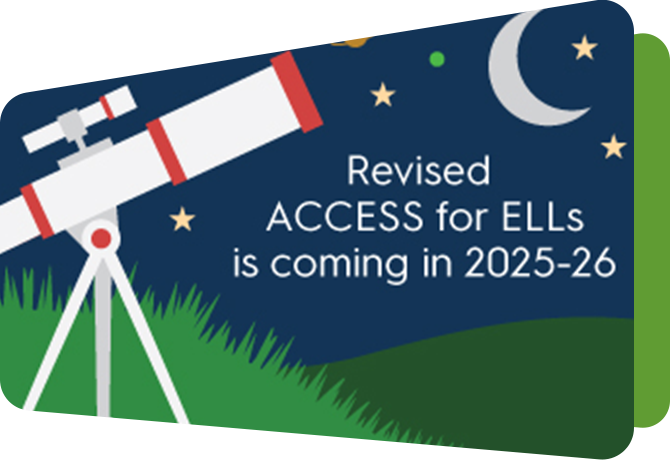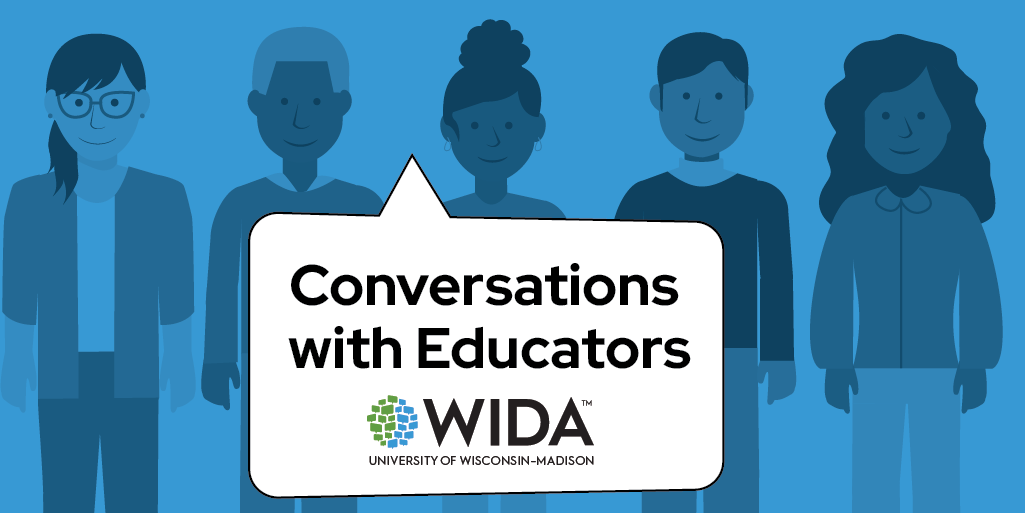Resources/Recursos
Featured Resources



All resources/Todos los recursos
Filter resources by:
Resources/Recursos
Using WIDA MODEL to support instructional planning for multilingual learners
In this Focus Bulletin, we aim to help readers better understand how WIDA MODEL test scores may be used to support instructional planning decisions for multilingual learners and their teachers. We describe the rich resources available from WIDA to help educators understand what the test scores mean. We also explain how these resources may be used, along with MODEL test scores to help inform where multilingual learners have opportunities to further develop their English language skills.
Published February 2022
Authors: Mark Chapman, Heather Elliott, Jennifer Feldmann
Released February 2022
Multilingual Children and Their Families
This WIDA Snapshot provides an overview of who multilingual children are, the benefits of promoting home language(s), and initial ideas for developing reciprocal partnerships with multilingual families.
Resource DetailsReleased February 2022
Examining Growth at the Intersection of IEP and (Long-Term) EL Status
Motivated by findings of a 2018 WIDA report pointing to large overlap between ELs with Individualized Education Program (IEP) designations and those ELs who could be identified as LTELs, this study further focuses on these dual-identified students. Grouping ELs by ever-IEP (i.e., being assigned an IEP at any point in the longitudinal record) and never-IEP status, we compare these two subgroups’ English language growth trajectories across time. Our findings show consistent trends of differential growth and reclassification rates for these two subgroups.
Published November 2021
Authors: Narek Sahakyan, Glenn Poole
Released November 2021
WIDA ELD Standards Framework, 2020 Edition - Kindergarten Materials
This resource includes the Kindergarten materials that are part of the WIDA English Language Development Standards Framework, 2020 Edition. The materials specific to this grade level have been pulled together to provide educators of students in Kindergarten with a smaller, more manageable booklet to support their implementation of the WIDA ELD Standards Framework in their classroom.
Resource Details View Download NowReleased October 2021
WIDA ELD Standards Framework, 2020 Edition - Grade 1 Materials
This resource includes the grade 1 materials that are part of the WIDA English Language Development Standards Framework, 2020 Edition. The materials specific to this grade level have been pulled together to provide educators of students in grade 1 with a smaller, more manageable booklet to support their implementation of the WIDA ELD Standards Framework in their classroom.
Resource Details View Download NowReleased October 2021
WIDA ELD Standards Framework, 2020 Edition - Grades 2-3 Materials
This resource includes the grades 2-3 materials that are part of the WIDA English Language Development Standards Framework, 2020 Edition. The materials specific to this grade-level cluster have been pulled together to provide educators of students in grades 2-3 with a smaller, more manageable booklet to support their implementation of the WIDA ELD Standards Framework in their classroom.
Resource Details View Download NowReleased October 2021
WIDA ELD Standards Framework, 2020 Edition - Grades 4-5 Materials
This resource includes the grades 4-5 materials that are part of the WIDA English Language Development Standards Framework, 2020 Edition. The materials specific to this grade-level cluster have been pulled together to provide educators of students in grades 4-5 with a smaller, more manageable booklet to support their implementation of the WIDA ELD Standards Framework in their classroom.
Resource Details View Download NowReleased October 2021
WIDA ELD Standards Framework, 2020 Edition - Grades 6-8 Materials
This resource includes the grades 6-8 materials that are part of the WIDA English Language Development Standards Framework, 2020 Edition. The materials specific to this grade-level cluster have been pulled together to provide educators of students in grades 6-8 with a smaller, more manageable booklet to support their implementation of the WIDA ELD Standards Framework in their classroom.
Resource Details View Download NowReleased October 2021
WIDA ELD Standards Framework, 2020 Edition - Grades 9-12 Materials
This resource includes the grades 9-12 materials that are part of the WIDA English Language Development Standards Framework, 2020 Edition. The materials specific to this grade-level cluster have been pulled together to provide educators of students in grades 9-12 with a smaller, more manageable booklet to support their implementation of the WIDA ELD Standards Framework in their classroom.
Resource Details View Download NowReleased October 2021
Examining English Learner Testing, Proficiency and Growth: Before and Throughout the COVID-19 Pandemic
This report examines English learners’ (EL) testing, proficiency and growth in the academic years of 2018–19, 2019–20 and 2020–21, using population-level data from ACCESS for ELLs Online, administered across the WIDA Consortium to students identified as ELs. The objective of the report is to shed light on the impact of the COVID-19 pandemic on ELs’ educational outcomes.
October 2021
Authors: Narek Sahakyan, H. Gary Cook
Released October 2021
WIDA MODEL Online 2020 Field Test Technical Report
The purpose of this technical report is to describe the 2020 content refreshment and field test of WIDA MODEL Online tests for grades 1–12.
Resource Details View Download NowReleased May 2021
Putting It All Together: Next Steps for Using the 2020 Edition
In this webinar, the WIDA standards development team discusses and models the tools, provided in the 2020 Edition, for initiating critical conversations with school leaders and colleagues.
Resource DetailsReleased March 2021
Curricular Considerations: Introduction to Collaborating Around the 2020 Edition
The WIDA ELD Standards Framework, 2020 Edition brings new practical ways for all educators working with multilingual learners to conceptualize the development of content and language together through asset-based, equitable, and rigorous approaches in curricular design. This session will encourage participants to think about what collaboration looks like in these contexts.
Resource DetailsReleased February 2021
Introduction to the Updated Key Language Uses
One of the components of the WIDA ELD Standards Framework is the Key Language Uses (KLUs). The KLUs summarize the most prominent language uses across disciplines, helping educators organize and prioritize curriculum and instruction. Learn about the updated KLUs – Inform, Narrate, Explain and Argue.
Resource DetailsReleased February 2021
Introduction to the 2020 Edition
Members of the WIDA standards development team share a high-level overview of what’s new and exciting in the WIDA English Language Development Standards Framework, 2020 Edition. Intended for SEA representatives, district leaders, and EL and content teachers.
Resource DetailsReleased January 2021
ACCESS for ELLs Parent Letters (multiple languages)
This letter, available in many languages, contains general information about ACCESS for ELLs and is meant to accompany ACCESS for ELLs score reports as an explanation for parents and guardians. It is provided in an editable format to allow districts and schools to include additional information regarding test administration dates and state policy.
Resource Details
Released December 2020
Performance of Technology-Enhanced Items in Grades 1–12 English Language Proficiency Assessments
Technology-enhanced items (TEIs) are innovative, computer-delivered test items that are more authentic and interactive than traditional multiple-choice items (MCIs). This study examines the performance of grades 1–12 English learners on TEIs compared to MCIs on the reading domain of ACCESS for ELLs Online.
Published December 2020
Authors: Ahyoung Alicia Kim, Rurik L. Tywoniw, Mark Chapman
Released December 2020
Introduction to the WIDA ELD Standards Framework, 2020 Edition
This video provides an introductory overview of the WIDA English Language Development Standards, 2020 Edition. It briefly highlights how the 2020 Edition fosters the assets, contributions, and potential of multilingual learners.
Resource DetailsReleased December 2020
Making Science Multilingual: An Interdisciplinary Program and its Evolution
This report discusses an interdisciplinary and interorganizational endeavor to support the science education of multilingual youth: the Making Science Multilingual program. More specifically, the report addresses the rationale for the program, milestones it accomplished, resources it required, and challenges it faced.
Published November 2020
Authors: Daniella Molle, Weiqiong Scarlett Huang
Resource Details View Download Now
Released November 2020
Translanguaging
This focus bulletin explores translanguaging from the perspective of four educators, spanning kindergarten through high school. Translanguaging, a common practice among multilingual people, can be explained as using all languages and language varieties available to communicate and understand the world around oneself. The bulletin provides specific ideas on how to use translanguaging to create spaces for students' multilingualism and includes reflection questions to help educators adopt translanguaging strategies in their practice.
Resource Details View Download Now
Released September 2020




